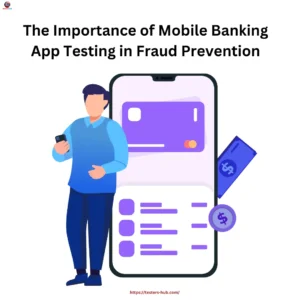The Role of Mobile Banking Application Testing in Fraud Prevention
banking application testing is essential for ensuring the security and reliability of mobile banking applications. banking application testing involves rigorous evaluation to identify vulnerabilities and ensure protection against fraud in mobile banking app testing. By leveraging professional banking application testing services, financial institutions can safeguard their apps from security breaches and malicious attacks. Ultimately, banking application testing plays a critical role in providing secure, seamless user experiences in the digital banking landscape.
The Importance of Mobile Banking App Testing in Fraud Prevention
Why Mobile Banking App Testing is Critical
As mobile banking becomes a key part of daily financial management, it also attracts cybercriminals seeking to exploit security flaws. Hackers use techniques like phishing, malware, and other methods to compromise banking apps and steal sensitive customer data. Mobile banking app testing is essential for identifying these vulnerabilities early and fixing them before they can be exploited.
Banking app testing involves a comprehensive review of all aspects of the application, including authentication processes, data encryption, and transaction verification, to ensure the app is secure. This testing minimizes the risk of unauthorized access and protects users from potential financial fraud. By investing in thorough mobile banking application testing, financial institutions can ensure that their apps comply with the latest security regulations, safeguard customer data, and provide users with a secure platform for conducting their banking activities without fear of fraud or breaches.
Key Areas of Focus in Mobile Banking App Testing
When conducting banking app testing, it is essential to focus on several critical areas to ensure the app remains secure, efficient, and functional. These areas are fundamental to preventing fraud and protecting user data. Let’s dive into some of the most important aspects of mobile banking testing that contribute to fraud mitigation and overall security.
1. Security Testing for Banking Applications
Security is a critical focus during banking application testing. Mobile banking apps store highly sensitive information like account credentials, passwords, and credit card details. Ensuring this data is safeguarded from unauthorized access is essential. Security testing verifies the app’s security measures, including encryption techniques, authentication protocols, and user access controls. This proactive approach helps identify and resolve weaknesses, preventing security breaches and protecting users’ financial information. Therefore, it is crucial to ensure this data is kept secure from potential breaches or unauthorized access. Security testing for banking applications evaluates the app’s security measures, focusing on encryption protocols, authentication processes, and access controls.
A key component of bank test applications is ensuring that the app follows up-to-date industry standards for encryption, such as Secure Socket Layer (SSL) and Transport Layer Security (TLS). These protocols help protect user data during transmission. Regular security testing for banking applications is vital for identifying weaknesses or vulnerabilities that could be targeted by cybercriminals, thus preventing potential fraud and ensuring users’ information remains safe.
2. Authentication and Access Control Testing
Strong authentication mechanisms are key to ensuring that only authorized users can access their banking apps and perform sensitive transactions. Mobile banking application testing should include validating user authentication processes, such as multi-factor authentication (MFA), biometrics (fingerprint or facial recognition), and PIN codes.
Test cases for mobile banking applications should simulate attempts to bypass authentication mechanisms, ensuring that the app correctly verifies user identities before granting access. Additionally, banking application testing should focus on testing the app’s access control features. For instance, administrators may have access to more features than regular users, so testing for proper role-based access control is essential to prevent fraudulent activities from within the app.
3. Penetration Testing to Identify Vulnerabilities
Penetration testing plays a vital role in banking app testing, as it allows ethical hackers to attempt breaking into the app and exploiting potential weaknesses. This type of testing helps developers discover flaws that could be exploited by cybercriminals to steal data or perform unauthorized transactions.
Penetration testing can uncover vulnerabilities such as weak password management, insecure APIs, or issues with data encryption. By performing these tests, banks can address weaknesses before malicious attackers have a chance to exploit them, thereby reducing the risk of fraud.
4. Simulating Fraudulent Activities with Test Cases
One of the most effective ways to identify potential security flaws in mobile banking apps is by simulating fraudulent activities. Test cases for banking applications should include a range of scenarios where fraudsters attempt to perform unauthorized actions, such as account takeovers, fraudulent transactions, or accessing sensitive information. By simulating real-world fraud scenarios, developers can assess the app’s ability to detect and prevent fraudulent activities.
Mobile banking application testing must include testing for common fraud techniques such as phishing, fake login pages, and social engineering attacks. For example, test cases could simulate a user attempting to make a large wire transfer from a new device or log in from an unusual location. The app should be able to detect these suspicious activities and prompt additional verification or lock the account to prevent fraud.
5. Validating Payment Gateways and Transaction Security
One of the main functions of a mobile banking app is enabling secure transactions. Therefore, ensuring the security of payment gateways and protecting transactions from fraud is crucial. banking application testing should validate the security of payment processes, ensuring transaction data is encrypted and free from vulnerabilities.
Internet banking app testing should focus on evaluating how payments are processed and confirming that sensitive financial data is protected throughout. This process also includes verifying compliance with security standards like PCI DSS (Payment Card Industry Data Security Standard) to ensure the secure handling of payment information.
Mobile Banking App Testing Process: A Step-by-Step Approach
The process of mobile banking application testing involves several steps that ensure the app’s security, functionality, and performance meet the highest standards. Here is a step-by-step overview of the typical mobile banking testing process:
Step 1: Requirement Gathering and Analysis
Before beginning the testing process, it is essential to gather the requirements from key stakeholders, including the bank’s IT department, security experts, and business owners. These requirements should include security expectations, compliance needs, and a list of features that the app should support. Banking app testing can then be tailored to meet these specific requirements and ensure that the app will perform optimally.
Step 2: Test Plan Development
Once the team gathers the requirements, they move on to developing a detailed test plan. The test plan should outline the testing strategy, specifying the scope, test cases to execute, and areas of the app that need attention. A key focus of this step is ensuring that the fraud prevention mechanisms are tested thoroughly.
Step 3: Test Case Development
After finalizing the test plan, the next step is to develop specific test cases for mobile banking apps. These test cases should cover various scenarios, such as user login, account management, transaction handling, and security features. It’s also essential to test for common fraud tactics, including unauthorized access attempts, fraudulent transactions, and phishing attacks. This helps ensure the app is prepared to handle potential security risks and protect user data.
Step 4: Test Execution
In the test execution phase, the mobile banking app is tested in realistic conditions, using both real and simulated user data. The testing team will execute the predefined test cases to observe how the app functions under various conditions. Additionally, the team will evaluate the app’s security performance, specifically focusing on its ability to detect and block fraudulent activities. This phase helps identify any potential vulnerabilities in the app and ensures that the necessary security protocols are functioning correctly.
Step 5: Bug Reporting and Issue Resolution
During the testing process, testers will notify the development team directly of any problems or vulnerabilities they find. After that, the developers will try to resolve these problems. The team will test the app again after applying the fixes to make sure the problems have been fixed.
Step 6: Regression Testing
After the app has been updated or fixed, regression testing is performed to ensure that the changes do not introduce new issues or vulnerabilities. Regression testing ensures that existing functionality, particularly security measures, continues to work as expected.
Step 7: Final Review and Deployment
Once the app passes all tests, including security and compliance checks, the team will prepare it for deployment. The mobile banking application testing team will conduct a final review to ensure they have met all testing objectives and confirm that the app is fully secure before releasing it to users.
Conclusion
As mobile banking apps become vital for managing finances, the need for effective banking application testing grows. Mobile banking application testing is crucial for ensuring security, performance, and functionality, especially in preventing fraud. Through thorough testing, including evaluating security protocols and simulating fraud scenarios, vulnerabilities can be identified and fixed before attackers exploit them. For banks and financial institutions, regular mobile banking testing is a proactive way to prevent fraud. By rigorously testing apps, banks can protect customer data and maintain service integrity. Whether launching a new mobile app or improving an existing one, banking application testing ensures a secure, trustworthy, and seamless user experience.











